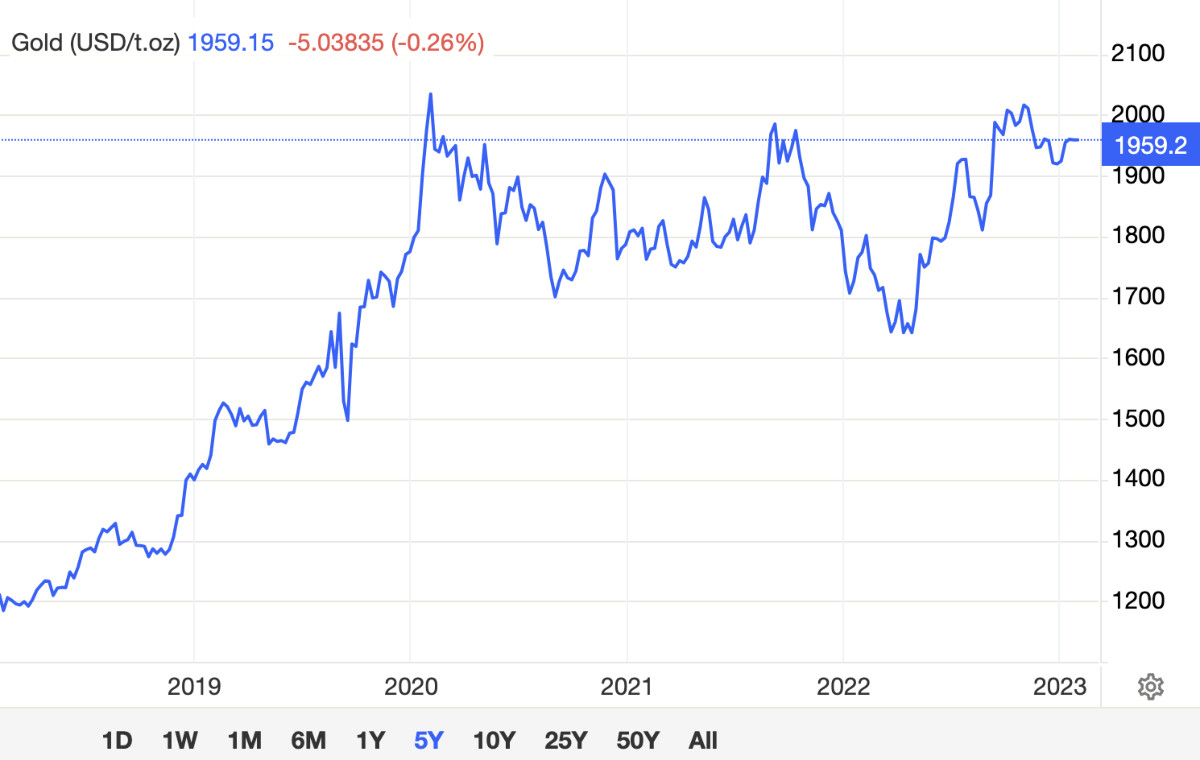Prospect of a new Golden Age: ASX gold explorers return to Victoria’s Goldfields – Part 2

Explorers turn their attention to Victoria for a new golden age. Pic: Getty Images
- ASX explorers bank on more gold to be found in what could be a new golden age for Victoria
- First AU is exploring for gold in East Gippsland near the historic mining area of Swifts Creek
- Falcon Metals is to completes more than 80,000m of aircore drilling at its Victorian projects this season
Australia is recognised as the second largest gold producer in the world, producing 320 metric tonnes in 2022, compared to leader China churning out 330 metric tonnes during the same period.
And while Western Australia is the leading state in Australia these days for gold exploration and production, explorers are also increasingly looking to Victoria with its vast mining heritage of the precious metal.
READ: Prospect of a new Golden Age: ASX gold explorers return to Victoria’s Goldfields – Part 1
Rallying gold prices in the past five years have encouraged explorers to revisit old mining grounds in Victoria, putting new kinds of technology and techniques to use, while emerging explorers hit greenfield opportunities. The S&P/ASX All Ords Gold index (ASX:XGD) is up ~28% during the past year.
When times are tough investors tend to rely on gold more than equities – and tough they have been with the Covid-19 pandemic, war in Ukraine and global economic uncertainty over recent years boosting the price of the precious metal.
Five year gold price

So which ASX explorers are turning their attention to Victoria for the prospect of a new golden age?
First Au (ASX:FAU)
FAU is exploring for gold in East Gippsland near the historic mining area of Swifts Creek with its focus on the Snowstorm and Haunted Stream projects over a tenure encompassing more than a combined 2,250km2.
The explorer says new geological understanding show the rocks in the region are the same as in the central Victorian goldfields.
“New tectonic and structural interpretation of the area – in which the FirstAU Haunted Stream and surrounding tenure is believed to have been continuous along strike to the Central Goldfields of Victoria during the important time of gold mineralisation, brings it back to attention, with FirstAU the first movers,” the company says.
FAU’s tenure over the Haunted Stream goldfields has an 8.5km strike length and contains more than 150 historic workings over a major tectonic scale structure, including Ernestine, Hibernia, Rob Roy and Hans Lode.
Previous mining at Haunted Stream produced more than 25,000oz of gold during late 1800s and early 1900s. FAU says the area has been poorly tested by previous explorers and many of the workings remain open at depth.
The company’s other focus of Snow Storm historically produced more than 100,000oz with similar geology to Haunted Stream.
FAU says the mineralisation at Snowstorm occurs within shears and quartz veins hosted within Ordovician sediments.
The explorer recently announced maiden Haunted Stream drilling successfully intersected extensive shallow gold. Results from the first two holes include 12.9m @ 3.57g/t Au, including 7.3m @ 5.1g/t Au and 0.2m @ 36.88g/t Au from 38.3m and 11.1m @ 2.65g/t Au, including 4.1m @ 4.1g/t Au and 0.25m @ 12.81g/t Au from 51.5m.
Haunted Stream drilling is now complete with assays for holes 3, 4 and 5 expected to be released shortly.
Southern Cross Gold (ASX:SXG)
SXG operates three projects in Victoria. Its flagship Sunday Creek Project – situated ~60km north of Melbourne – is a shallow orogenic (epizonal) deposit, which the explorer says resembles Fosterville-style mineralisation.
During the period of 1880-1920, gold mining took place over a vast 11km trend, resulting in a reported total production of 41,000oz of gold at a grade of 33g/t gold.
Subsequent drilling efforts from the 1990s to the 2000s focused on the shallow surface workings that spanned an area of 100m in width and 800m in length, but only reached depths of 80m. SXG says consequently, the entire field remains open for exploration along the strike and at greater depths.
The explorer recently purchased a further 0.65ha of freehold land next to both the main access and current freehold ownership to the Sunday Creek Project, further securing surface access and providing additional area for any potential future gold operation.
SXG already owns 132.64ha of freehold property covering both the Sunday Creek project drill area and areas for potential extension of the zone to the east, within 19,365ha of granted exploration tenements.
The explorer says diamond drilling continues with four diamond rigs now focused on testing gold structures down to 800m depth and 1.2km along strike at Sunday Creek.
SXG also has the Redcastle project in a JV with Nagambie Resources (ASX:NAG), a shallow orogenic historic high-grade field held within a tenure area of 56.7km.
Redcastle is 2km along strike from Mandalay Resources’ Costerfield mine exploration licences and 24km east of TSX-listed Agnico Eagle’s Fosterville mine.
SXG recently announced the 100% purchase of the Laura PL6415 prospecting licence for $300k at Redcastle. The company says the acquisition has secured 100% of one of the higher-grade parts of the Redcastle goldfield, where recent drilling has identified very high grades, up to 704g/t Au and 24.7% Sb within continuous and targetable structures above a 1.3km long and a coherent IP anomaly.
SXG and NAG also have a JV in the 14km long Whroo goldfield, located 130km north of Melbourne, considered one of the largest historic epizonal goldfields in Victoria. It remains untested at depth with alluvial gold mining starting at Whroo during the initial gold boom of the 1850s.
Kaiser Reef (ASX:KAU)
This gold miner operates the high-grade A1 mine, one of Victoria’s top-tier gold mines, having operated since 1861 with a historical average production of 25g/t of gold.
In January 2021, Kaiser successfully acquired 100% ownership of Centennial Mining Ltd, thereby gaining full control over Centennial’s assets, including the A1 gold mine, the Maldon goldfield (currently under care and maintenance), and the Maldon processing plant, which is used for treating A1 ore.
KAU in July announced successful drilling at the A1 Mine opened up the opportunity to develop an intermediate reef close to the previously mined Victory and Welcome reefs.
Diamond drilling at the 1410 South mining development returned standout assays such as 0.3m at 315g/t gold from 1.5m (A1UDH-536) and 9.45m at 25.6g/t gold from 10.95m including 0.5m at an eye-popping 356g/t gold from 12.1m (A1UDH-537).
Additionally, the 1250-840 reef, currently under extraction, has yielded remarkable displays of visible gold, adding to the project’s allure.
With the potential to double ore production and focus on mining high-grade ore, the A1 Mine could experience a significant boost in its economic viability.
During March quarter, the A1 Mine generated $9.48 million in revenue from the sale of 3,376oz gold, while incurring total costs of $8.09 million.
“We are effectively doubling our production and it is certainly my strong belief that we’re not going to be doubling our mining costs, so our profit margin per ounce will increase,” managing director Jonathan Downes told Stockhead.
Presently, KAU is engaged in mining operations at the A1 site and transporting the extracted ore to the Maldon processing plant for further refinement.
However, it has also made a significant recent discovery, defining a resource of 1.2 million tonnes with a grade of 4.4g/t gold at the Maldon gold field. Notably, this goldfield has historically produced an impressive 2.1 million ounces at a grade of 28g/t.
The gold mineralisation at the Maldon site remains open at depth, and deeper drilling efforts have validated the presence of high-grade gold in those depths.
“It is literally open-ended, it is just a matter of stepping out and improving and expanding the resource base,” Downes says.
Falcon Metals (ASX:FAL)
The Pyramid Hill Gold Project, fully owned by FAL, was acquired in late 2017 and currently encompasses an expansive area of more than 7000km2, primarily situated in Victoria’s Bendigo region.
The project is strategically positioned north of the renowned high-grade historic Bendigo Goldfield, which has yielded over 22 million ounces of gold, and is also adjacent to the impressive ~9 million ounce-producing Fosterville Gold Mine held by AEM.
In its June quarterly report, FAL reported it had been continuing its major drilling program, completing 34,051m of aircore drilling and 756.4m of diamond drilling across the project including at Ironbark, Wandoo and Banksia, as well as regional first pass drilling.
Drilling for the current season concluded in June with the final aircore drill rig demobilised from site, completing a total of 81,852m of aircore drilling and 2,132.9m of diamond drilling.
Final assay results are expected in the September 2023 quarter.
MD Tim Markwell told Stockhead the junior is well cashed up for further exploration with more than $17 million in the bank at the end of the June quarter.
“We’ve done more than 80,000m of aircore drilling this season which is probably the most by a junior gold explorer ever in Victoria and are certainly producing results,” he says.
“We have a cluster of high-grade results at the Wandoo prospect which is open to the south so that will be a priority to explore in the next field season starting around November.
“We’ve also discovered new areas of anomalous gold from our first-pass regional screening program at Pyramid Hill where we will do wide spaced drilling, with these areas also requiring follow-up infill drilling so we can vector in on the high-grade.”
Catalyst Metals (ASX:CYL)
CYL has a 50:50 joint venture with Hancock Prospecting over the Four Eagles Gold Project, which is part of the larger Bendigo Gold Project that covers the entire Whitelaw Gold belt trending 70km north from Bendigo.
Drilling has identified a number of high-grade prospects at Four Eagles including Boyd’s Dam, Iris Zone, Hayanmi, Pickles and Cunneens.
In June, CYL released a maiden mineral resource for Boyd’s Dam and the Iris Zone beneath it. Boyd’s Dam contains an indicated and inferred mineral resource of 580kt at 5g/t Au for 93,000oz, whilst Iris returned a bonanza inferred mineral resource of 85kt @ 26.2g/t Au for 70koz.
Further mineral resources at Hayanmi are expected to be returned in H2.
In order to access the high-grade prospects year round, CYL is proposing to develop an exploration decline beneath the wheat fields. The 3.6km decline will allow cost effective drilling of prospects that don’t have a surface expression.
Kalamazoo Resources (ASX:KZR)
The explorer has several gold projects in Victoria including the Castlemaine Goldfield in the Bendigo zone of central Victoria., which consists of three granted tenements for a total holding of 304 km2.
Its South Muckleford Gold Project comprises two exploration tenements spanning 161km2 and is 10km west of its Castlemaine Gold Project.
South Muckleford contains a highly prospective goldfield with proven endowment and historical high grade gold production.
KZR’s Myrtle Gold Project is within the prospective hangingwall of the Axe Creek Fault, a major northwest trending structure which strikes sub-parallel to the Fosterville fault.
In its latest quarterly report KZR says the projects is considered prospective for both Fosterville-style epizonal orogenic Au as well as intrusion related Au ± Mo deposits.
The explorer also holds a strategically important tenement position in the Tarnagulla Goldfield, along with its latest acquisition, the vast 1,609 km2 Mt Piper Gold Project from Coda Minerals (ASX:COD).
KZR says the acquisition aligns with its strategy of acquiring and exploring high-quality gold projects in Victoria with a target threshold of 1Moz at grades >10 g/t Au.
The FAU, SXG, KAU, FAL, CYL & KZR share price today:
At Stockhead, we tell it like it is. While First AU and Kaiser Reef are Stockhead advertisers they did not sponsor this article.
Related Topics

UNLOCK INSIGHTS
Discover the untold stories of emerging ASX stocks.
Daily news and expert analysis, it's free to subscribe.
By proceeding, you confirm you understand that we handle personal information in accordance with our Privacy Policy.








